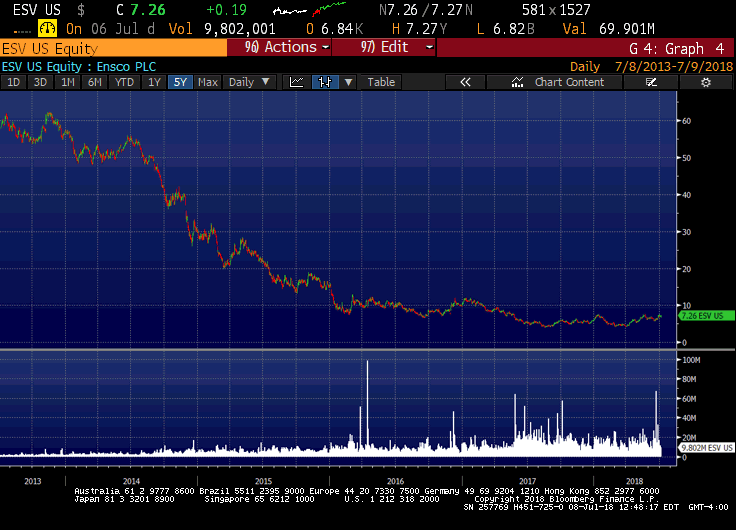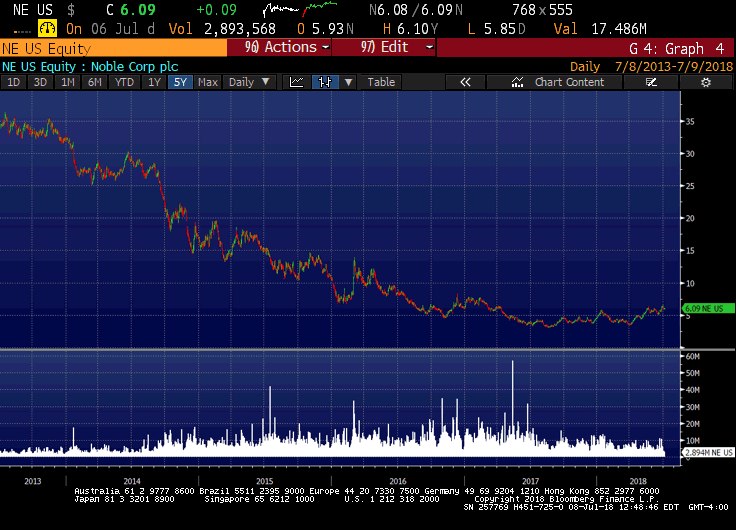Ever since oil prices collapsed in 2014, there has been an underlying belief that oil prices could not go up due to endless oversupply from shale oil. Now, 4 years later, that supply growth is stalling. There are various reasons for this, but underlying everything else, is the fact that the basic economics of shale just aren’t that robust. This is partly due to high decline curves and increasing cost inflation, but also due to basin discounts as a result of insufficient pipeline capacity. Do you really want to hit the best part of your decline curve during a massive basin discount? Finally, many of the Tier 1 drill locations in the US have already been hit and most basins are transitioning to Tier 2 locations that are less attractive—even before taking into account the impact from the first three issues (decline curves, cost inflation and take-away capacity). Throughout the shale boom, there has always been a belief that new technology would slow the decline curves, but that hasn’t yet happened. The net result is that many basins are working hard, just to keep existing production in place and shale is no longer growing like it was supposed to be on the spreadsheets. Do you remember how shale was compared to farming? Just plant it and hedge it.
Q2 hedge fund letters, conference, scoops etc
During this time, energy producers have been under shareholder pressure to stop spending and focus on dividends, buybacks and debt reduction. This has resulted in a near dearth of offshore exploration. Despite Brent oil prices in the high 70s; there’s still not been a move back offshore. I think that’s about to change. If you’re an oil major, do you want to dump more money into the Permian where costs are ramping at a time when you get a $20 basin discount? Or do you want to lock in an oil rig at generationally low prices, earn global Brent prices and target assets that you have decades of experience with? Offshore oil still represents roughly a third of global oil production and this production is declining at about 3 million barrels a day. Shale cannot replace all of that and keep up with demand growth—hence the reason that oil prices have been increasing for the past two years. An underlying belief in shale seems to have tricked majors into reducing long-cycle spending, just at a time when global demand is increasing and certain nations are having severe export problems. This is certainly good for oil prices.
I already have exposure to this trend through Tidewater (TDW – USA) which is up about 10% since I wrote about it this January. Tidewater is the world’s second largest Offshore Service Vessels (OSV) operator, with the industry’s best balance sheet. I believe I purchased it at around 20% of the replacement value of its assets, yet Tidewater has spent most of the past few decades trading at a premium to replacement value. Recent increases in industry scrapping, along with a view that many obsolete cold-stacked vessels will never re-enter the global fleet, leaves me to believe that the OSV sector may actually be a lot tighter than many people think it is. We’re already seeing rates spike in the North Sea. I suspect that other regions will also see spikes in the near future. I recently added a good deal to my Tidewater position, along with purchasing some more of the 2023 62.28 strike warrants. Clearly, this means I see Tidewater more than doubling from today’s prices. In fact, I suspect it trades for well over $100 a share before those warrants expire. Tidewater is now my second largest position.
In April, I was on a boat off the Isle of Capri in Italy, and I saw this OSV that looked to be sporting Tidewater colors. Turns out it was working on repairing a sewer line to the mainland. Never found out if it was currently owned by Tidewater.
As oil prices begin to stabilize at a higher price, I’ve wanted to increase my exposure a bit more to undervalued equipment. I’ve therefore purchased shares of Ensco PLC (ESV – USA) and Noble Corp PLC (NE – USA). They each trade at massive discounts to replacement value, have debt that’s reasonably termed out with minimal near term maturities and sufficient backlogs and liquidity to survive until the recovery comes. These charts show that even a marginal recovery could lead to multi-bagger potential—especially as neither has done anything too dilutive during the trough in prices.
For the past three years, every time oil has had a spike higher, the offshore complex has rallied strongly and then immediately sold off when the monthly fleet status reports have come out and shown no change in contracting. This is to be expected—contracting takes time, involves hiring staff and mobilizing a lot of equipment. Why would Wall Street expect a dramatic change a few weeks after a $5 spike in oil? Instead, we need sentiment amongst producers to change from strictly shale, to a blend of onshore and offshore. Recent conversations with industry professionals lead me to believe we are at that inflection point. Until oil got to the $60s, the majors were hesitant to think that it would stay there. Now that we’re stabilizing in the $70s, it is much more likely that contracting is indeed coming back and 2019 budgets—set in Q4 2018 should set the tone. I want to be positioned before that happens.
When will the recovery come? I don’t know, but we’ve already hit the bottom. Utilization is actually starting to increase for shorter-term contracts and no one has noticed, as these companies are still near their all-time lows. If I can buy a lot of equipment at around 25 cents on the dollar of replacement value, during a time when demand is increasing and the current liquidity run-way gives me time for the investment to work, it sure seems like a good bargain to me.
Article by Adventures In Capitalism







